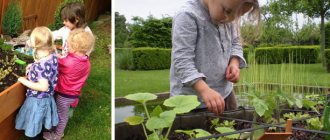Preview:
Municipal budgetary preschool educational institution
“Kindergarten No. 22 “Crane” in the city of Safonovo, Smolensk region
Summary of direct educational activities
Educational field "Cognitive development"
section "Labor education"
“Caring for indoor plants. Watering"
Prepared by: Elena Viktorovna Usova
teacher of the highest qualification category
Goal: Consolidate knowledge about the basic needs of indoor plants.
1. Develop an interest in indoor plants.
2. Strengthen the skills of caring for indoor plants
3. To instill in children an interest in plants, a desire to observe and carefully care for them
Materials: aprons, rags, watering cans, a basin of water, card diagrams for caring for plants, several balsam sprouts planted in pots.
Preliminary work: conversation about indoor plants; reading poems and riddles about plants; looking at indoor plants; working together to care for plants; work according to the schemes “Plant needs”, “Watering indoor plants”.
Educator: Guys, guess the riddle:
The windows are green,
(Children guess that these are plants).
2. Conversation about indoor plants:
Educator: Guys, it’s spring outside, and at this time all living things are awakening from sleep. Tell me, why can we say about plants that they are alive? What are the signs of a living thing? (because plants grow, reproduce, breathe, eat, die).
Educator: Correct. Plants also absorb bad air, make us happy and calm, decorate our home, move, turning towards the sun. Educator: Tell me, what are the names of the plants that grow in pots in the room?
Educator: Correct. Plants are all different and they have different names. (I show and name some flowers).
Educator: Name the flowers that grow in our group. (zonal geranium, Uzambara violet, balsam, chlorophytum, coleus, Decembrist (zygocactus).
Educator: We told you that all plants are living. And since they are alive, they cannot be ignored. In order for them to grow and bloom, they need to be looked after.
Educator: What does it mean to care for flowers? (children's answers)
Educator: Yes. First, the plant must be planted in the ground, then water it with water, loosen the soil, and also, every flower definitely needs light and warmth.
Educator: It turns out that you know a lot about how to care for plants that live in houses next to each other.
The flower was sleeping and suddenly woke up, (torso to the right, to the left.)
I didn’t want to sleep anymore, (torso forward, backward.)
He moved, stretched, (Hands up, stretch.)
He soared up and flew. (Hands up, right, left.)
The sun will just wake up in the morning,
The butterfly circles and curls. (Spin around.)
Educator (shows table-drawings of caring for indoor plants): Guys, try to guess from these tables which of the works on caring for our flowers are depicted here. (Water, spray, loosen, remove dust from leaves)
Educator: Guys, you and I drink water whenever we want. Animals too. How do we know if our plants are thirsty? We decided to water them, but maybe they don’t need water at all now? (children's answers)
(If children find it difficult, then leading questions are asked)
Educator: That's right, well done! Plants should be watered when the soil is dry to the touch and the leaves are limp.
Educator: Do we have such a plant in our group? (No). And here it is (indoor balsam is placed on the table in a state of wilting). Compare these two balsams: how are they different? Why? They didn’t forget to water it, but deliberately didn’t water it for several days so that you could see what would happen to the flower if it wasn’t watered. Impatiens love moisture very much. They need a lot of water. In summer, the soil in the pot should always be moist. In winter, excess moisture should not be allowed, as the plant will rot. Remember: no plant should be allowed to wilt; it will make it very sick.
Educator: Guys, who wants to try to water our wet Vanka or Impatiens - that’s what people call him?
(The child takes a watering can and waters the flowers from above.)
Educator: Guys, was the flower watered correctly? (answers). No, you can’t water flowers like that. It is necessary to water carefully, in a thin stream, press the spout of the watering can to the edge of the pot, and do not pour water on the leaves. Like this (showing how to water flowers). Also, the water should be settled and at room temperature.
Educator: Children, tell me, why should the water be poured in a thin stream and not directly at the root? (Children's answers)
Educator: If you water with a strong stream, the soil of the pot will be washed onto the table and there will be dirt. And most importantly, with a strong stream you can expose the roots of the flower and they will dry out.
Educator: Now look at your plants (everyone has one pot with a balsam sprout on the table). Do they need to be watered? Why do you think so? (the soil in the flower is dry and light)
Educator: That's right, if the soil is light, dry to the touch, even sometimes in cracks, then it needs to be watered.
3. Practical work on watering; as it progresses, the teacher corrects the children’s actions:
Educator: We take watering cans and start watering. If you have already watered your plant, watch what happens to the water. (some people quickly pour water into the saucer, some don’t. What conclusion can be drawn? (children’s answers).
Educator: That’s right, if you pour slowly, then not so much water runs out, but if it’s all at once, then a lot).
Educator: So, how will you water the plants at home and in the group? What will you do if water leaks past? (Children's answers). Find on your tables what you will use to wipe up spilled water, wipe everything carefully, rinse the cloth in a bowl of water (children clean up the tables, put the plants in the place indicated by the teacher, wash their hands).
Educator: Are you satisfied with your work? What can you teach your mother or anyone else at home today? (Children's answers) How do you know if your plants need to be watered? What kind of water should I take?





